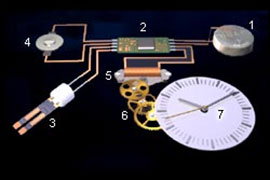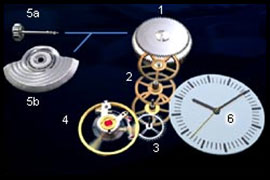The Swiss watch industry produces essentially two types of watch: electronic quartz watches and mechanical watches. Three in every four watches are electronic. Despite being produced in smaller numbers, mechanical watches are extremely important in value terms, since they represent more than 75% of total value.
Quartz watch
In a quartz watch, the heart of the watch consists of the integrated circuit. The division of time is effected by a quartz oscillator, vibrating under the effect of electrical energy supplied by a battery. The energy source takes the form of a miniaturised battery with a lifespan of several years. The division of time is effected by a quartz oscillator which transforms energy from the battery into vibrations.
Quartz watches are extremely accurate thanks to a high frequency of vibration (32 kHz). Their annual variation is consequently very low: in the order of one minute per year, i.e. less than a second a day.
Quartz watches come with two types of display. The most common is the analogue display, i.e. with hands.
Watches with a digital display contain liquid crystals, which receive the impulses they need to display the time directly from the integrated circuit. Therefore, there is no mechanical transmission of energy.
These two types of display can be combined to provide a range of indications, such as the time of day and short, measured times, for example.
Diagram of a quartz watch
1) Battery
2) Integrated circuit
3) Quartz
4) Trimmer regulating the frequency
5) Stepping motor
6) Gear-train
7) Analogue display

Mechanical watch
A standard mechanical watch has around 130 components assembled in three subassemblies, namely the energy source, the regulating parts and the display. The number of components is naturally higher for watches with complications (chronograph, calendar, phase of the moon, fly-back hand, etc). The energy supplied by the spring is transmitted by the gear-train. The escapement transmits impulses, while the balance divides the time. Winding, either manual or automatic via the rotor, tightens the spring.

Diagram of a mechanical watch
1) Mainspring
2) Gear-train
3) Escapement
4) Oscillating balance
5) Winding stem / Rotor
6) Analogue display
Automatic quartz watch
Swiss watchmakers have overcome the challenge of combining these two types of technology. They have created a watch movement which operates as a quartz movement but recharges like a mechanical movement, thereby obtaining an automatic watch with the accuracy of quartz.
Its operating principle is simple but nonetheless revolutionary: an automatic recharging mechanism (oscillating weight) tightens the mainspring which, when released, starts up a mini-generator able to convert mechanical energy into electrical energy. This energy is accumulated in a capacitor. Thereafter the system behaves like a traditional quartz watch, with the integrated circuit controlling the distribution of energy and providing the impulses required to drive the stepping motor.


 Knowledge
Knowledge